Writing Round-Up
| Name: |
Angela Turnier |
| School: |
PS124 |
| Address: |
40 Division St |
| City: |
New York, New York, 10002 |
| Original Project: |
Writing Round-Up |
| Author: |
Rosa M. Sampedro |
| URL: |
http://teachersnetwork.org/teachnet-lab/miami/2004/sampedro.htm |
How did you modify this unit for use in your own classroom?: We began with a map study activitiy. Students looked for geographic landforms of western America. They placed clay on map to represent mountains and rivers. The focus question posed was: What are the limitations posed for travel by those landforms? (2) Writing tall tales as a literacy extension of a social studies unit on westward expansion.
List your primary instructional objectives for your students.
| |
Tall tales were a way that pioneers coped with their journeys along the unknown expanse of the Oregon Trail. |
| |
Geographic landforms and animals found in the west were barriers to pioneers journeys west. Learn major geographic landforms along the Oregon and Santa Fe Trails. See how they would be obstacles for pioneers to complete their journey west. |
| |
Tall tales was a genre unique to the 1840's - 1860's in America. Their main characters were pioneer superheroes and heroines. They were filled with hyperbole. Define and use hyperbole. |
| |
Tall tales were a type of historic fiction. The difference between historic fiction and tall tales. |
What role did technology play in this curriculum unit?: Research: The following websites were used by students: www.atozteacherstuff.com/lessons -- read tall tales, "Paul Bunyon" and "John Henry" www.americanfolklore.net - learn the purpose of tall tales for the pioneers www.42explore.com/talltale - read different versions of the tall tale, "Johnny Appleseed" worksheets-- dep.disney.go.com/educational/lessons?id (disney tall tales worksheet; writing tall tales lesson 3 Rubric) --watch videos "The Greatest American Tall Tales and Legends," published by Schlessinger Media, A Division of Library Video Co. (Paul Bunyon. John Henry)
How did you assess and evaluate student performance?: My class used the rubrics from "Writing Round-Up" which assessed character development, setting, exaggerations, as a guide to assess their original tall tales. We used the Disney rubric after the piece was written because it was easier for my class to understand. Writing process conferencing followed the development of each tale written. Each child included a statement of a geographic obstacle and how his/her tall tale character overcame that obstacle. They were also assessed as to their fulfillment this purpose.
Please tell us briefly about your background & teaching experience: Ms. Turnier has been a teacher for 18 years and has taught Talented and Gifted students at PS124 for 13 years. She taught students in grades K, 1, 2, 5 and as an adjunct in Fordham University's graduate teacher education program. Ms. Turnier is the recipient of Teacher Center/UFT grant in literacy
What are your recommendations for other teachers interested in adapting this unit?: My class is studying Westward Expansion and is already knowledgeable about the reasons for pioneers leaving their home. This helped them create a tale that reflected the plight of the pioneers.
Samples of Student Projects
| |
Children found a geographic obstacle a pioneer might face. Each child were instructed to first informed me of this problem and how the tall tale hero/heroine would overcome this obstacle. Children placed the name of their character on the class map. They then wrote their tales using hyperboles . Afterwards each child was required to construct a "Tall Tale Character." Each student drew a head and inserted the tale as the body and added arms and legs to the writing. Students then dressed the hero/heroine with odd fabric pieces. The longer the tale the "taller the tale character." Published pieces were displayed on the outside bulletin board. Tall Tale Person |
| |
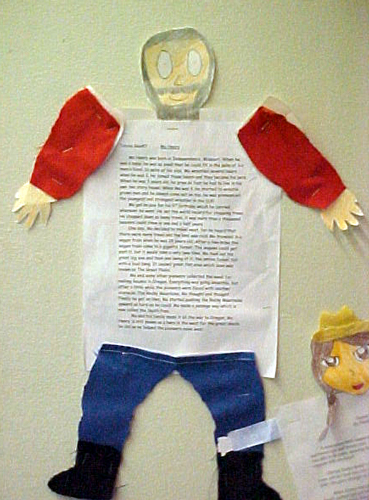 |
| |
|
| |
Each child used postcards to post name of hero, setting (state), natural obstacle, and superhuman characteristic that allowed him/her to overcome the obstacle and survive the west. |
| |
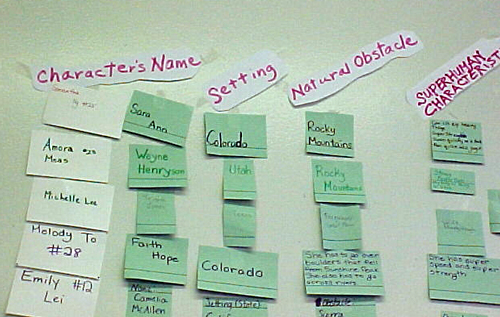 |
| |
|
| |
Students used clay to show elevations and rivers. After posting their tall tale plan, each student taped the name of his/her hero in the state and setting of the tall tale. Students moved arrow post-its with their names as they moved along in the writing process. This allowed each student to be aware of how he/she worked within the writing process.,Tall Tale Planning Chart |
| |
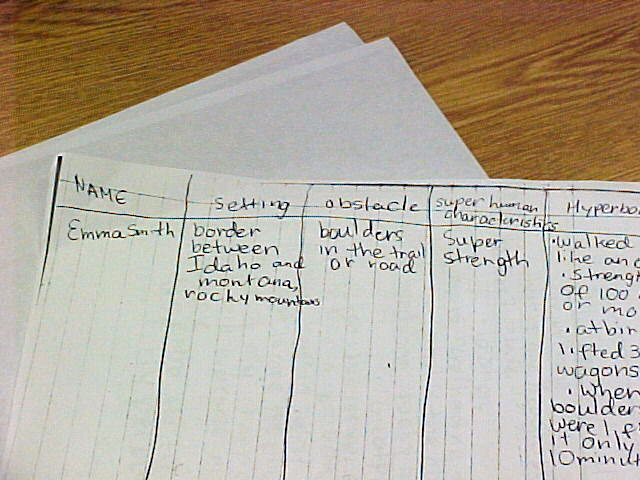 |
| |
|
| |
Tall Tale Criteria Chart |
| |
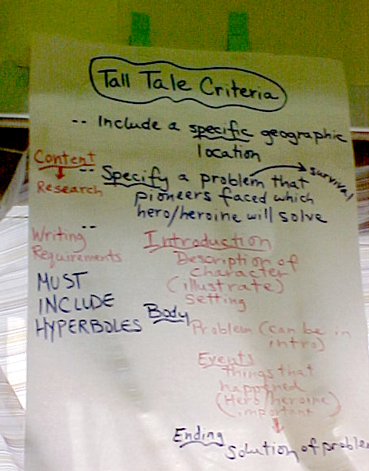 |
| |
|
| |
Student Store Planner |
| |
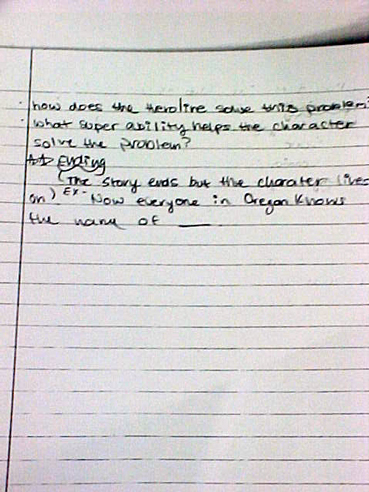 |
| |
|
| |
|
| |
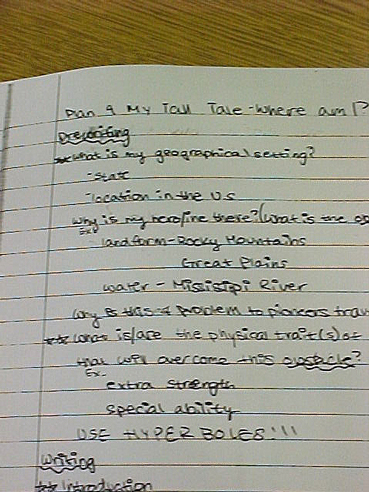 |
|